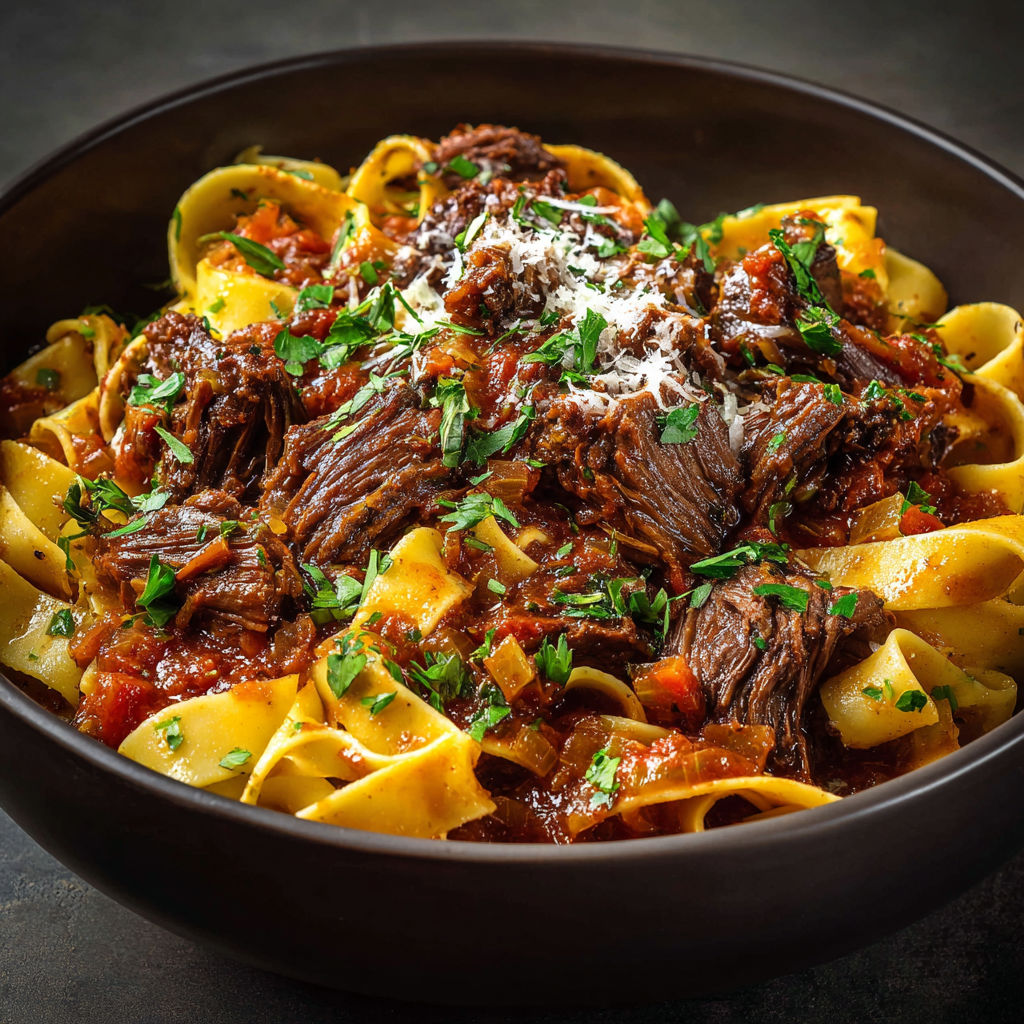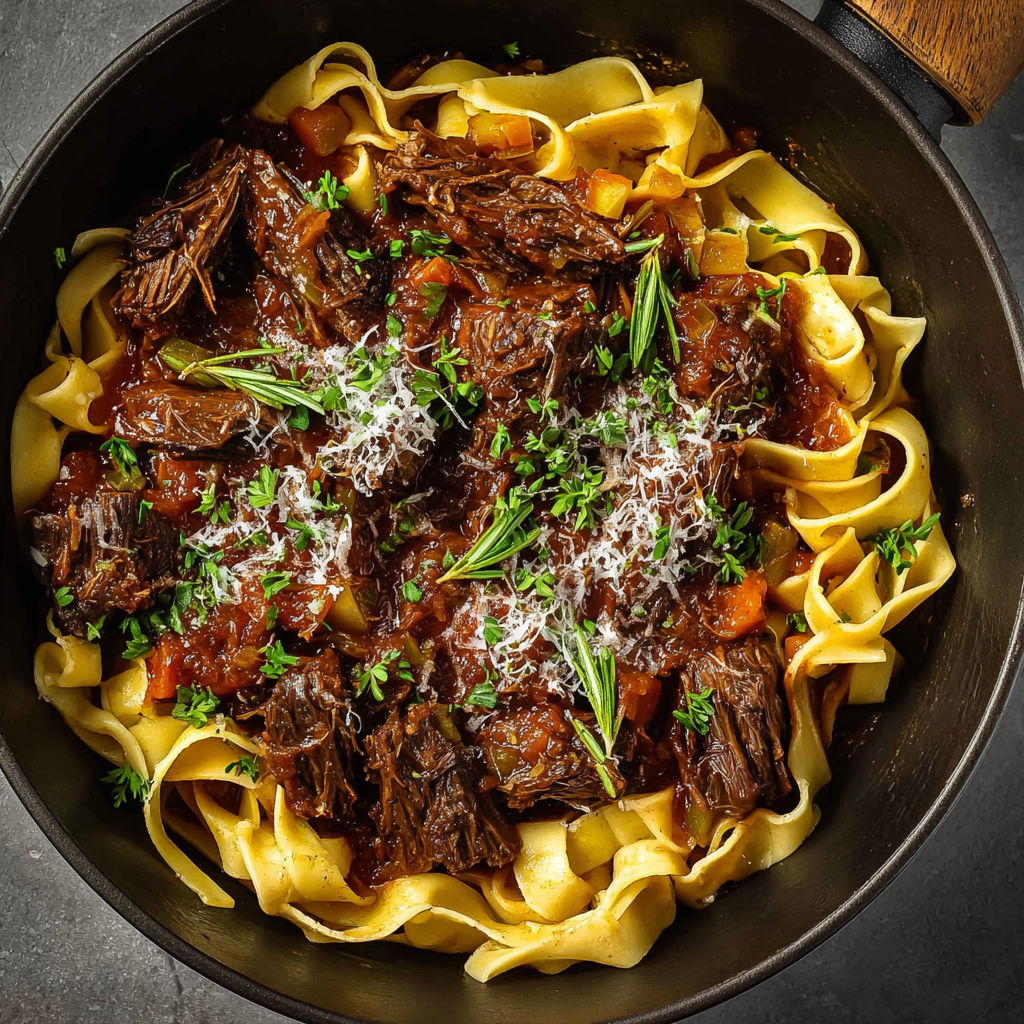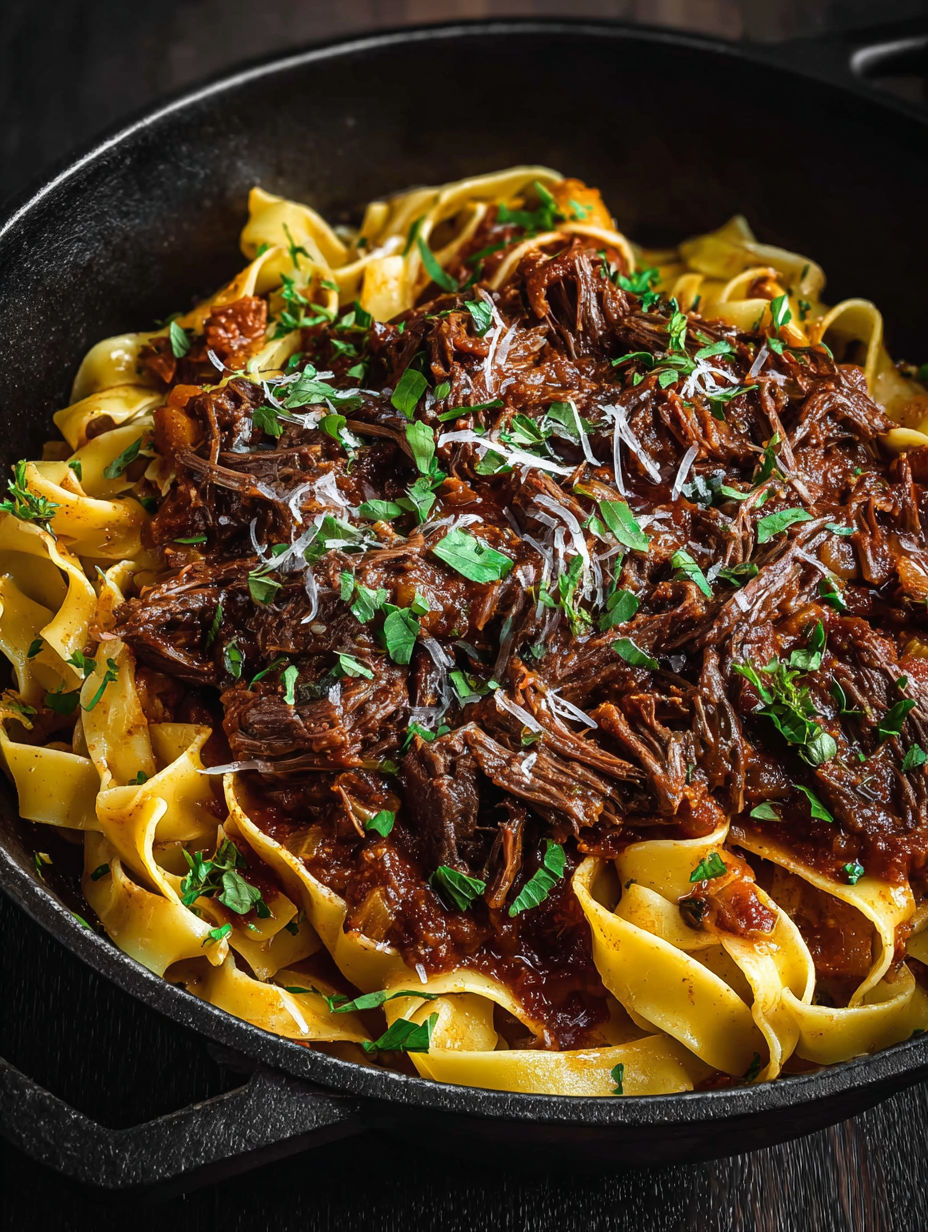 Pin it
Pin it
This filling short rib ragù turns everyday ingredients into a luxurious pasta topping through long, slow cooking. The deep, mouthwatering flavor comes from properly browning the meat and letting it cook until it falls apart at the touch of a fork. While it needs time, most of the cooking doesn't need your attention, giving you a stunning meal that's perfect for family gatherings or when you want to impress.
I cooked this ragù for the first time during a freezing weekend when I wanted something warm and cozy but good enough for company. Watching tough meat turn buttery soft amazed even the pickiest eaters at my table. These days, everyone asks for it whenever someone important stops by.
- Beef short ribs give a rich taste and turn super tender with slow cooking pick pieces with good fat marbling for the tastiest results
- Light olive oil helps brown the meat without adding too much flavor you can use canola or avocado oil instead
- White onion carrot and celery make the traditional flavor foundation Italians call soffritto
- Garlic cloves add wonderful aroma always pick fresh over pre-minced for better taste
- Tomato paste gives deep savory notes and helps thicken things up the tube kind with double-concentration tastes best
- Red wine brings tanginess and complexity go with something you'd enjoy drinking
- Crushed tomatoes add texture and brightness San Marzano type gives the best flavor if you can find them
- Herb bundle with rosemary thyme and parsley stems adds aroma without leaving bits in the sauce
- Bay leaves bring subtle flavor don't forget to take them out before eating
- Sherry or red wine vinegar cuts through the richness with a touch of tang
- Pasta wider shapes like pappardelle or tagliatelle work best with this chunky sauce
Delicious Short Rib Ragù Instructions
- Season and sear
- Sprinkle cubed short ribs generously with kosher salt all over. Warm oil in a Dutch oven on medium-high until it shimmer. Work in small batches to avoid crowding, and brown the meat on each side until deeply colored, taking about 3-4 minutes per side. This step builds the foundation of all your flavor. Put browned meat on a plate and keep going until all pieces look gorgeous.
- Build the flavor base
- Using the same pot with leftover fat, toss in diced onion, celery, carrot, and chopped garlic. Cook for 3-4 minutes until everything softens and smells good. Add tomato paste and seasonings, and cook 2-3 minutes more until the paste gets a bit darker. This cooking makes the tomato taste richer and gets rid of any tinny flavor.
- Deglaze and simmer
- Add red wine, scraping the pot bottom hard with a wooden spoon to get all those stuck brown bits. This step puts all that concentrated goodness back into your sauce. Return the browned short ribs to the pot, pour in broth and crushed tomatoes, then tuck in the herb bundle and bay leaves.
- Slow cook to perfection
- Let the mixture come to a simmer, then partly cover and lower heat to keep a very gentle bubbling. Cook for 2 to 2½ hours, checking now and then to make sure there's still enough liquid. Your ragù is done when the meat breaks apart easily with a fork. The tough parts in the short ribs will have melted away, making your sauce smooth and rich.
- Finish and serve
- Take out and throw away herbs and bay leaves. Pull apart the soft meat right in the pot. Taste and add more salt if needed, then mix in vinegar to wake up the flavors. If your sauce looks too runny, cook it uncovered for another 15-30 minutes until it's as thick as you want. Serve over pasta cooked with a bit of bite, topped with fresh Parmigiano Reggiano and chopped parsley.
The real wonder of this dish happens during the long, slow cook. I can't forget when I first made this for my wife's Italian grandma who looked doubtful when I mentioned using short ribs instead of the usual veal. After trying one bite, she smiled and wanted to know how I made it—a win I still feel proud of today.
 Pin it
Pin it
Keeping It Fresh
This ragù gets better as it sits and the flavors mix together. Keep leftovers in a sealed container in the fridge for up to 4 days. The sauce will get much thicker when cold because of the natural gelatin from the short ribs. When warming it up, add a little broth or water to make it the right thickness. For keeping it longer, put cooled ragù in freezer containers, leaving some room at the top for expansion, and freeze for up to 3 months. Let it thaw in the fridge overnight before gently warming on the stove.
Swap These Ingredients
While short ribs make the most delicious version of this ragù, you can use chuck roast or stew meat to save money. The cooking time might change a bit, but you'll follow the same steps. For something lighter, try turkey thighs which also get better with slow cooking. If you don't want to use alcohol, replace the red wine with more beef broth plus a spoonful of balsamic vinegar to add similar tanginess and depth. If you can't have dairy, nutritional yeast gives a savory flavor similar to Parmigiano Reggiano.
Ways To Enjoy It
Besides the classic pasta pairing, this flexible ragù works great in many dishes. Put it over creamy polenta for a comforting meal without pasta. Use it to fill homemade ravioli or layer in lasagna for an amazing main course. For fewer carbs, try it over roasted spaghetti squash or mashed cauliflower. It even tastes surprisingly good spooned over creamy hummus and eaten with warm pita. For a fancy starter, put small amounts on toast with a thin slice of Parmigiano Reggiano.
 Pin it
Pin it
Frequently Asked Questions
- → Can I cook with bone-in short ribs?
Absolutely, bone-in ribs bring even more flavor. Just shred the meat and discard the bones after cooking.
- → What meat could I use instead of short ribs?
Stewing beef or cubed chuck roast is a budget-friendly swap. They get just as tender when slow-cooked.
- → Is it okay to prep this ahead?
Totally! It’s even better after a day or two in the fridge as the flavors combine. Reheat slowly on the stove before eating.
- → What pasta type works well?
Thicker pasta styles are ideal. Pappardelle, orecchiette, rigatoni, or cavatelli are some great options.
- → How should I store extra sauce?
Seal leftover ragù in a container and refrigerate for up to 4 days. For longer storage, freeze it up to 3 months. Thaw it overnight in the fridge before reheating.
- → What else could I pair with this besides pasta?
Try this over creamy polenta, in lasagna, as ravioli filling, or even served alongside roasted veggies. It’s very versatile!
